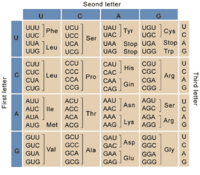Genetic Code
The genetic code is a three-letter (triplet) code defining the transfer of the information from nucleic acids to proteins. Codon is a successive string of three nucleotides. Nucleotides found in human DNA are adenine (A), guanine (G), thymine (T) and cytosine (C). In RNA one of them - thymine - is replaced by uracil (U).
According to the order of codons in the mRNA, the individual amino acids are inserted into nascent polypeptide chain. Amino acids are the main building components of all the proteins.
The genetic code has 4 main features:
The genetic code is degenerate[edit | edit source]
We know 20 main amino acids (not counting selenocysteine and pyrrolysine), but they can be coded for by 64 different triplet combinations - codons. It logically means that one amino acid is coded by more than one codon. We can say that the nucleotide at the last position is the least important. Some amino acids are coded just by one codon (methionine, tryptophan). On the other hand serine can be coded for by 6 possible combinations.
The genetic code is non-overlapping[edit | edit source]
During proteosynthesis the genetic code is read sequentially, i.e. one codon at a time. There is no possibility to skip some of the nucleotides. The process starts from an initiation codon and then continues until it reaches termination codon in a single translational reading frame. This does not preclude the existence of overlapping genes, though, each with its own reading frame.
The genetic code is almost universal[edit | edit source]
The genetic code is pretty similar in most of the organisms. It means that codon, which codes methionine in human, does the same in prokaryotes. This point is not exactly true as recently, scientists have discovered many exceptions from this rule. The genetic code is not universal, but it is still predominant.
The genetic code is unambiguous[edit | edit source]
This feature is related to the first point: one amino acid can be coded by several different codons; however, each codon ONLY codes for one amino acid, not more. Hence the unambiguity of the genetic code.
Links[edit | edit source]
Related articles[edit | edit source]
Sources[edit | edit source]
- MURRAY,, et al. Harperova biochemie. 3. edition. 2002. ISBN 80-7319-013-3.


